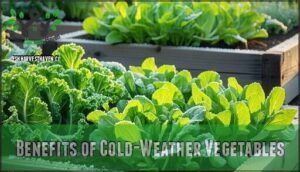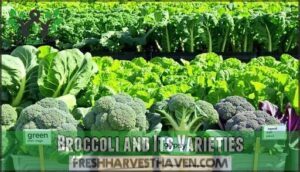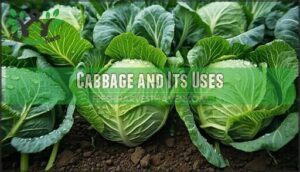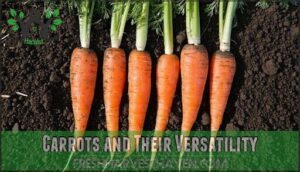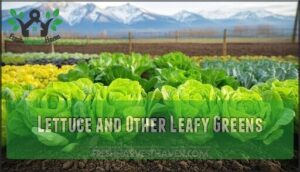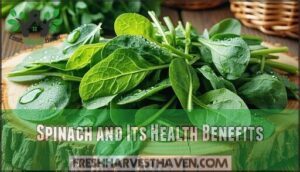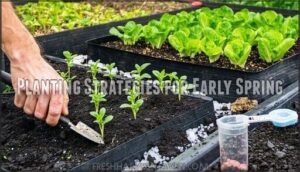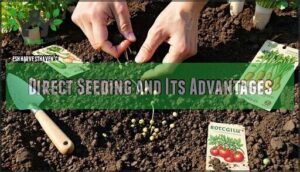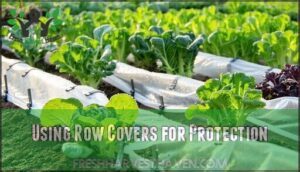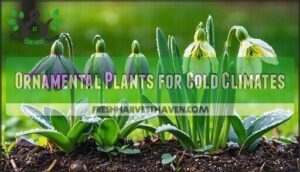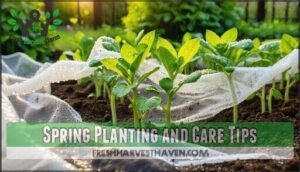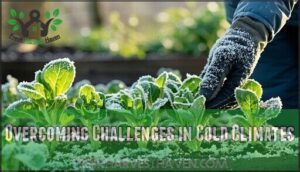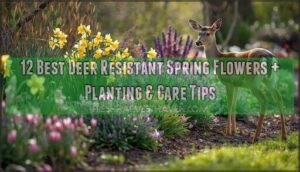This site is supported by our readers. We may earn a commission, at no cost to you, if you purchase through links.
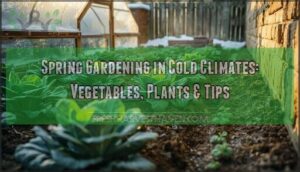
Focus on cold-hardy champions like broccoli (tolerates 15°F), cabbage, carrots, and spinach, which laugh at late frosts that would devastate tender crops.
Your hardiness zone tells you which varieties will actually make it through your spring—not just which ones sound good on paper.
Row covers, cold frames, and south-facing wall placements create warm pockets that give seedlings breathing room during unpredictable spring weather, extending your harvest window before summer even arrives.
Table Of Contents
- Key Takeaways
- Gardening in Cold Climates
- Benefits of Cold-Weather Vegetables
- Best Vegetables for Cold Climates
- Early Spring Vegetable Planting
- Ornamental Plants for Cold Climates
- Spring Planting and Care Tips
- Overcoming Challenges in Cold Climates
- Frequently Asked Questions (FAQs)
- How cold is too cold for gardening?
- What temperature is too cold for spring flowers?
- Can plants grow at 40 degrees?
- What can I plant in winter for spring?
- What is cold climate gardening?
- Can you grow plants in a cold climate?
- When to plant cold season vegetables?
- What plants grow in cold weather?
- How do you choose a plant for cold climate gardening?
- How cold is too cold for spring plants?
- Conclusion
Key Takeaways
- Cold-climate spring gardening succeeds when you start with workable soil around 40°F and choose frost-tolerant crops like broccoli (survives 15°F), cabbage, spinach, and carrots that thrive despite unpredictable late frosts. – Understanding your USDA hardiness zone gives you a precise roadmap for selecting varieties bred to survive your winter minimums, though you’ll still need to account for spring frost dates and microclimate variations that zones don’t predict. – Season extension tools like row covers, cold frames, and black plastic mulch create warm pockets that raise temperatures 4-10°F, letting you plant weeks earlier and harvest longer without fighting your climate. – Strategic timing matters more than effort—succession planting every two weeks, proper soil preparation with compost amendments, and monitoring soil temperature daily will outperform rushed planting every time.
Gardening in Cold Climates
Spring gardening in cold climates starts with three essential foundations that’ll set you up for success.
These three foundations—soil prep, vegetable choice, and knowing your hardiness zone—determine whether you’ll harvest crisp lettuce in May or watch your seedlings shrivel after a surprise frost.
Preparing The Soil for Spring
In cold climates, the soil can stay frozen until late March or even April, so getting your timing right for spring prep is key.
Kick things off with a soil test to check the pH (most veggies are happiest between 6.0 and 6.8). Use a broadfork to loosen any compacted spots for better drainage.
Then, mix in an inch or two of compost—this wakes up the microbes and gets nutrients moving.
Apply mulch layers or black plastic sheeting to speed soil warming and regulate soil temperature. These frost protection strategies prepare your beds weeks earlier:
- Test pH and adjust with lime or sulfur
- Add 2-3 inches of aged compost
- Cover beds with dark mulch to capture heat
- Use raised beds for faster spring warming
Choosing The Right Cold-Weather Vegetables
Your soil’s ready. Time to choose vegetables that actually enjoy the cold.
Cool season crops like broccoli, cabbage, and spinach handle soil temperatures down to 40°F and actually taste better after light frosts. These frost tolerant crops form the backbone of successful cold climate vegetable selection.
Root vegetables like carrots, turnips, and radishes offer versatility—they tolerate freezing nights and store well through winter. Hardy leafy greens such as kale and arugula provide continuous harvests when you use season extension techniques like row covers.
For optimal success, choose frost tolerant varieties specifically bred for your region’s challenges.
Understanding Hardiness Zones
Understanding hardiness zones gives you the roadmap to smarter plant choices. The USDA Plant Hardiness Zone Map divides North America into 13 climate bands based on average annual minimum winter temperatures, with each zone reflecting a 10°F difference. The 2023 update—drawing from over 13,400 weather stations—shows many areas have shifted to warmer half-zones, meaning your vegetable garden may now accommodate plants that once struggled in your cold climates. Remember that ecoregions offer more detailed environmental insights for gardeners.
Here’s how you can put this zone knowledge to work:
- Find Your Exact Zone: Check the latest Zone Map Updates for your microclimate—urban spots and lakeside areas often run warmer than surrounding land.
- Consider Canadian Zones: If you’re north of the border, these zones factor in frost-free days, wind, and snow cover for sharper accuracy.
- Recognize Planting Limitations: Zones predict winter survival, not spring frost dates or summer heat—critical for Spring gardening in cool climates.
Benefits of Cold-Weather Vegetables
Cold-hardy vegetables actually get better with a little frost—sweeter, crisper, and more flavorful. These tough crops can handle early spring weather while your tender plants are still waiting indoors.
Nutritional Value of Cold-Weather Vegetables
Cold-weather vegetables pack considerable nutritional value that makes your winter harvest worth the effort. Kale delivers 100% of your daily vitamins A, C, and K in just one cup, while parsnips provide 34% of your vitamin C needs.
These nutrient-rich vegetables and hardy leafy greens offer impressive mineral composition too—spinach supplies iron and magnesium, while collard greens deliver 27% of daily calcium.
Winter root vegetables develop enhanced antioxidant levels when exposed to frost, with cooling actually boosting vitamin content by up to 30% in some crops. Eating these vegetables can also provide benefits to your health, including supporting a healthy gut and immune system.
Increased Crop Yield and Diversity
When you stack different cold-hardy crops in the same garden bed, you’re not just growing more vegetables—you’re building a resilient food system that laughs in the face of unpredictable spring weather. Succession planting cool weather crops every two weeks keeps your harvest pipeline flowing steadily. Here’s how to get the most from your yield:
- Companion Planting pairs carrots with onions to deter pests while getting the most from space efficiency in your cold climate beds.
- Vertical Gardening structures hold up climbing peas and beans, tripling your yield per square foot without expanding your footprint.
- Variety Selection combines quick-maturing radishes with slower cold hardy vegetables like broccoli, filling gaps through strategic crop rotation.
By taking care of your microclimate and choosing veggies packed with nutrients, you’ll build a lively mix of crops that leaves single-variety garden beds in the dust.
Extended Harvest Season
By staggering your plantings and using protective structures, you can stretch harvests from early spring straight through winter’s chill. Succession planting every two weeks keeps leafy greens coming, while cold frames and hoop houses shield crops during frost. Plant covers add extra degrees on frigid nights, and drip irrigation under mulch sustains growth when rainfall drops.
- Succession planting delivers continuous harvests instead of overwhelming gluts
- Cold frames transform November into productive growing time
- Hoop houses push your season three weeks earlier in spring
- Frost protection lets hardy vegetables survive below-freezing nights
Best Vegetables for Cold Climates
When spring arrives in cold climates, knowing which vegetables can handle the chill makes all the difference. Here are five cold-hardy champions that’ll thrive in your garden even when temperatures dip.
Broccoli and Its Varieties
Broccoli cultivars offer considerable cold tolerance and reliable harvests in spring gardening. Field trials in Iowa showed Imperial broccoli delivering 0.28 lb/ft², outperforming both Gypsy and Belstar in cool-weather crops. You’ll find broccoli heads survive undamaged down to 15°F, making them perfect for cold climates.
| Variety | Days to Maturity |
|---|---|
| Green Magic | 57 days |
| Imperial | 70–80 days |
| Gypsy | 60–70 days |
| Purple Peacock | 92 days |
With over 105 commercially available options for vegetable gardening, you can select varieties matching your growing season. Imperial consistently achieved 100% "A" head density ratings in cold-season production, giving you restaurant-quality broccoli from your own garden.
Cabbage and Its Uses
Cabbage stands out as one of the most reliable cool-weather crops for vegetable gardening in cold climates. Mature heads tolerate temperatures as low as 18–20°F without damage, making transplanting cabbage an ideal strategy for early spring planting of cold-season vegetables. Peak growth happens between 60–65°F, which perfectly matches spring conditions in northern regions. Space your plants 9–12 inches apart to produce 2–3 pound heads ready for harvest before summer heat arrives.
- Cold hardiness: Survives harsh frosts that would devastate warm-season vegetables
- Cabbage bolting prevention: Avoid exposing plants to 10+ consecutive days at 35–50°F after warm periods
- Cabbage spacing matters: Proper 9–12 inch intervals improve head development and airflow
Carrots and Their Versatility
Carrots stand as one of the top 10 economically important vegetable crops globally, and they’re exceptionally well-suited for spring gardening in cold climates. You can direct-seed these root vegetables when soil temperatures reach 40°F, though cold stress will slow early growth.
Research trials show impressive carrot yields reaching up to 36.46 t/ha under prime cold conditions, though soil conditions greatly impact results—yields can drop to 27.98 t/ha when conditions shift. Root length commonly ranges from 16.41 to 20.09 cm in cold weather, with diameters between 2.26 and 2.96 cm depending on the season.
For best results in vegetable gardening, choose varieties like ‘Napoli’ for early spring harvests, and remember that consistent moisture and well-prepared soil are your tickets to success.
Lettuce and Other Leafy Greens
Leafy greens thrive when temperatures dip, giving you fresh salads even as winter lingers. Head lettuces grow successfully above 40°F, though you’ll need protection when nighttime lows drop below that threshold. Cold-Weather Varieties like Bibb lettuce can produce up to 94% marketable yield in high tunnel trials, while standard row covers guarantee growth at cold temperatures.
Here’s what works best for Extending Harvests:
- Lettuce delivers 10.2 to 12.6 units per planting area in cold weather trials
- Kale sweetens after frost and provides Nutritional Benefits year-round
- Arugula offers quick 30-day harvests with peppery flavor
- Spinach tolerates hard frosts down to 25–28°F while maintaining iron and folate content
These leafy greens require minimal Pest Control and simple Storage Techniques, making them reliable choices for your cold climate garden.
Spinach and Its Health Benefits
While lettuce fills your salad bowl, spinach delivers an even more impressive nutritional profile for cold climate gardens. This hardy vegetable tolerates hard frosts down to 25–28°F, continuing to produce when other greens falter.
You’ll capture abundant iron content, folate, and vitamin K—nutrients that aid energy production and bone health. However, cold storage effects matter: refrigeration at 39°F preserves 53% of spinach folate retention after eight days, while warmer temperatures accelerate carotenoid losses.
Plant this cold-tolerant champion in early spring or late fall for nutrient-rich vegetables that thrive in chilly conditions.
Early Spring Vegetable Planting
Start your early spring vegetables at the right time with a few practical techniques. You’ll want to understand planting strategies, direct seeding, and how row covers protect your crops.
Planting Strategies for Early Spring
Once you’ve selected your cold-hardy varieties, the real work begins with getting them into the ground at exactly the right moment—and that timing separates a thriving spring garden from a disappointing one. Early spring vegetable planting hinges on understanding your local microclimate and frost prediction patterns.
After you pick your cold-hardy varieties, timing matters more than anything else. Getting seeds in the ground too early or too late can make or break your spring harvest, and that comes down to knowing your local frost dates and how your yard’s microclimate actually behaves.
Your planting techniques should include:
- Microclimate mapping to identify warmer zones near south-facing walls
- Succession planting every 2 weeks for continuous harvests
- Soil temperature monitoring to confirm 45-55°F before seeding
- Row covers ready for unexpected cold snaps
- Indoor seed starting 4-6 weeks early for transplants
Early spring gardening rewards careful preparation over rushed enthusiasm.
Direct Seeding and Its Advantages
After planning your early spring strategy, you’ll find that direct seeding puts your cold-hardy vegetables right where they belong—straight into the ground without the hassle of transplanting. This method eliminates transplant shock entirely, letting roots establish quickly in cool weather.
Direct seeding skips the middleman—you’re putting cold-hardy vegetables straight into the ground, no transplanting required. This approach eliminates transplant shock entirely, so roots can establish quickly in cool weather.
Pay attention to planting depth: most cold-tolerant crops need just half an inch of coverage for best seed germination. You’ll save money on seed trays while developing hardier plants adapted to early spring vegetable planting conditions from day one.
Using Row Covers for Protection
Your seedlings need a safety net when late spring frosts threaten to undo weeks of careful planning. Row covers deliver reliable frost protection by trapping heat and shielding vulnerable plants from temperature swings.
Late spring frosts can really throw your garden plans for a loop, so give those seedlings some backup.
Row covers act like mini-blankets, helping plants hang onto warmth and weather sudden cold snaps.
- Temperature regulation advantage: Fabric types like floating row covers raise air temperature 4-8°F overnight, giving your cold-weather crops the buffer they need during unpredictable spring conditions.
Ornamental Plants for Cold Climates
Cold-climate ornamentals bring early color and structure to your spring garden when most plants are still dormant.
Here are five reliable options that won’t just survive—they’ll thrive in your growing zone.
Witch Hazels and Their Varieties
When winter’s chill still lingers in the air, witch hazels become your garden’s early-blooming heroes, unfurling fragrant ribbons of color long before spring officially arrives. These cold-hardy perennials thrive in zones 3-8, making plant selection for cold climate gardening remarkably straightforward.
Ornamental plants cold climates depend on don’t require elaborate protection—witch hazels handle frost with ease while delivering aromatic varieties that perfume winter landscapes.
| Variety | Bloom Color | Shrub Size | Medicinal Uses | Winter Blooms |
|---|---|---|---|---|
| Hamamelis mollis | Golden yellow | 10-15 feet | Astringent properties | January-March |
| H. virginiana | Pale yellow | 15-20 feet | Skin treatments | October-December |
| H. × intermedia | Orange-red | 12-15 feet | Anti-inflammatory | February-March |
| H. vernalis | Red-orange | 6-10 feet | Wound healing | January-April |
| H. japonica | Bright yellow | 10-12 feet | Antioxidant compounds | February-March |
Witch hazel propagation from softwood cuttings ensures you’ll multiply these performers for future seasons.
Pussy Willows and Their Care
If you’ve ever dismissed willows as messy or invasive, pussy willows might just change your mind—these early bloomers deliver that first flush of spring magic without demanding much in return. These cold-hardy perennials thrive in moist soil and full sun, making them reliable ornamental plants for cold climates. Catkin development begins in late winter, producing those distinctive fuzzy blooms before leaves emerge.
Essential care includes:
- Willow Propagation through stem cuttings taken in early spring for easy expansion
- Pruning Techniques after bloom—remove one-third of older stems annually to encourage vigorous growth
- Pest Control monitoring for aphids and willow beetles during catkin development
Plant selection matters: Willow varieties like Salix discolor and Salix caprea offer different growth habits for diverse ornamental plants cold climates demand.
Camellias and Their Requirements
Camellias might seem like delicate southern beauties, but with the right cold-hardy varieties and attention to their specific needs, you can coax these evergreen showstoppers into thriving even when your growing season runs short. Plant selection for cold climates starts with cultivars like ‘April Dawn’ or ‘Winter’s Snowman’ that tolerate temperatures down to -10°F.
Adapting to cold climates means mastering three essentials:
- Soil acidity: Test and maintain pH between 5.5-6.5 using sulfur amendments
- Winter protection: Apply mulch barriers and wind shields before first frost
- Fertilizing needs: Feed with acid-specific formulas in early spring only
Use proper pruning techniques immediately after blooms fade to shape growth without sacrificing next year’s flowers.
Dawn Viburnum and Its Characteristics
Dawn viburnum stands as a tough-as-nails shrub that laughs in the face of late winter frost, rewarding your patience with clusters of pink blooms that smell like clove-scented heaven weeks before your neighbors’ gardens wake up. This powerhouse among viburnum varieties thrives in zones 5-8, making it ideal for spring gardening in cold climates where plant selection for cold climates matters most.
You’ll appreciate its 6-10 foot shrub size that fills space without overwhelming smaller gardens. Bloom time starts in March or April, depending on your microclimate. For ornamental plants adapting to cold climates, dawn viburnum delivers fall color through burgundy-tinted leaves.
Pruning needs stay minimal—just shape after flowering to maintain structure and encourage next season’s display.
Cornelian Cherry and Its Uses
A powerhouse performer in your cold climate garden, the Cornelian cherry (Cornus mas) delivers striking yellow blooms before winter’s grip fully loosens. Thriving in zones 4-8, this ornamental value champion withstands temperatures to -25°F while producing tart, vitamin-rich fruits by midsummer. You’ll find numerous Cornelian cherry cultivars suited for spring gardening, each offering wildlife benefits through early nectar and late-season berries.
- Medicinal properties: High vitamin C content bolsters immune function and provides natural anti-inflammatory compounds
- Fruit processing methods: Transform harvest into jams, syrups, or traditional liqueurs using time-tested planting techniques
- Climate adaptation: Naturally hardy blooms resist late spring freezes that damage other fruit trees in cold climates
- Wildlife benefits: Early flowers feed pollinators when few other vegetables or ornamentals bloom
- Dual purpose: Stunning spring display transitions to productive fruit harvest by July
Spring Planting and Care Tips
Once you’ve picked your plants, the real work begins—getting them in the ground at the right time and caring for them through spring’s unpredictable weather.
After you’ve chosen your plants, you need to think about timing and spring weather—which can be all over the place in cold climates.
Planting at The Right Temperature
Temperature isn’t just a number on a thermometer—it’s the invisible switch that flips your seeds from dormant to thriving. Soil temperature impact drives seed germination rates more than any other factor. Most cold-hardy vegetables need soil between 40-60°F at 2-inch depth, but timing varies by crop and hardiness zones.
Soil temperature controls whether your seeds germinate or sit there doing nothing. Cold-hardy vegetables need 40-60°F at 2-inch depth, but the exact timing depends on what you’re planting and your hardiness zone.
Here’s your soil-warming game plan:
- Monitor soil temperature at seed depth each morning before planting
- Apply black plastic mulch to accelerate warming by 3-5°F
- Plant frost-tolerant crops first in your warmest garden zones
- Start heat-loving seeds indoors while outdoor soil catches up
- Track microclimates around structures for earliest planting opportunities
Master these temperature fundamentals, and you’ll gain weeks of productive growing time.
Get these temperature basics right, and you’re looking at two or three extra weeks of harvests.
Providing Adequate Moisture and Sunlight
Getting the temperature right is only half the battle—without proper water and light, even cold-hardy plants will struggle to thrive. Your vegetables need at least six hours of sunlight exposure daily to fuel strong growth and plentiful yields. Light requirements vary by crop, so position sun-lovers like broccoli where they’ll get sufficient sunlight.
Temperature matters, but it’s not everything—your plants still need the right amount of water and light to actually produce. Most vegetables want at least six hours of direct sun each day to grow strong and yield well. Different crops have different needs, so put your broccoli and other sun-lovers where they’ll actually get enough light.
Your watering method makes a huge difference—drip irrigation puts moisture right where roots can use it, keeping soil consistently damp without wasting water. Before planting anything, make sure your soil drains properly; soggy ground kills more seedlings than cold weather ever will. Add mulch around your drip lines to hold moisture in and keep soil temps more stable.
The key is checking your soil moisture regularly and tweaking your routine as spring weather changes.
Fertilizing and Pruning for Growth
Once soil temperatures climb and those first green shoots appear, smart fertilizing and pruning decisions can mean the difference between a struggling garden and one that thrives all season long. When your soil reaches 50°F, it’s time to apply slow-release organic fertilizers that match your vegetables’ nutrient needs. Fertilizer types matter—compost amendments and balanced blends at 1-2 pounds per 100 square feet give nutrient-rich vegetables the foundation they need. Work in 1-2 inches of compost during soil preparation to improve soil health and structure naturally.
As spring arrives and soil temps hit 50°F, your fertilizing strategy becomes critical. Slow-release organic fertilizers tailored to your vegetables’ needs are your best bet—think compost amendments and balanced blends at 1-2 pounds per 100 square feet.
These fertilizer types build the nutrient foundation that hungry crops depend on. Mix in 1-2 inches of compost during prep to naturally boost soil health and structure.
Strategic practices for peak performance:
- Apply compost tea to boost soil health while feeding hungry vegetables
- Time your fertilizing when roots can actually absorb nutrients
- Prune damaged branches before they become pest highways
- Layer organic mulch after fertilizing to lock in moisture
- Monitor plants weekly to catch deficiencies early
These combined efforts turn marginal growth into abundant harvests.
Overcoming Challenges in Cold Climates
Cold climate gardening throws some real curveballs your way, from surprise frosts to stubborn pests that don’t quit when temperatures drop.
Here’s how to tackle the three biggest challenges and keep your spring garden on track.
Dealing With Frost and Freezing Temperatures
Frost doesn’t have to be your garden’s enemy—with the right moves, you can turn freezing temperatures into an advantage for hardy crops. Start by tracking your local frost dates through weather apps—they’ll give you 80% accurate freeze warnings so you’re never caught off guard. Create warm pockets by planting near south-facing walls, where temperatures hover 5°F warmer than open ground. This microclimate management gives tender seedlings breathing room during cold snaps.
Frost hits every garden, but you can use it to your advantage. Check weather apps for local frost dates—they’re about 80% accurate and keep you prepared.
Plant near south-facing walls to create pockets that stay 5°F warmer than open areas. These warmer spots help tender seedlings survive unexpected cold snaps.
- Row covers and cold frames raise air temperature by 2-8°F, shielding plants from temperature fluctuations
- Soil moisture before a freeze acts as a heat battery—wet ground releases warmth overnight
- Hardening seedlings gradually over 7-10 days builds natural freeze damage repair mechanisms
- Mulch layers insulate roots, keeping the zone 5°F warmer than bare soil
Your cold snap strategies determine whether crops survive or surrender to frost.
Managing Pests and Diseases in Cold Weather
Cold-weather pests and diseases demand vigilant pest management through the spring season. Though cold temperatures naturally reduce pest activity by up to 60%, slugs and leaf-eating caterpillars remain aggressive, accounting for roughly 25% and 35% of crop damage, respectively. Disease prevention centers on controlling fungal pathogens—downy mildew and Botrytis thrive in cool, humid conditions, with disease rates jumping 40% in early spring. Your best defense? Integrated pest management combining multiple strategies.
Remove crop debris to cut slug damage nearly in half. Space plants properly to improve airflow and reduce disease spread by 35%. Choose resistant cultivars that show 50–75% fewer infections than standard varieties.
- Biological controls like Bacillus thuringiensis achieve over 70% control of caterpillars in spring gardens
- Weekly inspections catch early infestations before populations explode across your beds
- Cultural practices including sanitation and crop rotation reduce outbreaks by 60% when combined with resistant varieties
Using Greenhouses and Cold Frames for Protection
When spring frosts threaten your earliest crops, greenhouses and cold frames step in as your first line of defense against temperature swings. These structures provide essential frost protection while boosting temperature regulation by 5-10°F.
Position cold frames facing south for best plant protection, and don’t forget ventilation needs—proper airflow prevents overheating and controls humidity.
Material selection matters too: choose transparent covers that balance insulation with light transmission for effective frost management and pest management throughout your extended season.
Frequently Asked Questions (FAQs)
How cold is too cold for gardening?
How do you know when it’s safe to get your hands dirty? You can start planting hardy crops once soil temperatures hit 40°F—spinach, broccoli, and kale handle frost well, making early spring planting achievable in cold climates.
What temperature is too cold for spring flowers?
Most spring flowers struggle when temperatures drop below 50°F, though cold hardy varieties like pansies tolerate brief dips to 25–30°F. You’ll want frost protection once nighttime readings fall below 40°F to prevent frost damage and preserve bloom timing.
Temperature tolerance guidelines for spring flowers:
- Tender annuals (impatiens, begonias) suffer injury at 32–35°F and require soil warming before planting
- Semi-hardy types (petunias, marigolds) withstand light frost to 28–32°F with some frost protection measures
- Hardy perennials (primrose, hellebores) survive freezing in cold climates and adapt across multiple hardiness zones
- Frost-resistant bloomers (pansies, violas) endure temperatures down to 25°F, extending your growing season beyond standard frost dates
Can plants grow at 40 degrees?
Many plants thrive at 40°F, thanks to their frost tolerance and low temperature growth capabilities. Cold-hardy vegetables like broccoli, cabbage, and spinach handle cold soil germination well, with some varieties emerging even when soil temperature hovers at this threshold.
Understanding winter plant hardiness helps you succeed in cool weather gardening.
What can I plant in winter for spring?
Think beyond typical spring planting—winter sowing cold season crops like spinach, kale, and arugula in late fall sets you up for early spring harvesting.
These frost-resistant vegetables overwinter successfully, delivering fresh greens as temperatures rise, giving your cold-climate garden a head start.
What is cold climate gardening?
If you’re thinking about growing food in regions where winter bites hard, you’re stepping into cold climate gardening—a practice defined by short growing seasons and frost tolerance.
Understanding hardiness zones and climate zones helps you choose cold-weather vegetables that thrive despite cool weather.
Through smart soil preparation and gardening techniques like season extension, spring gardening in cold climates becomes not just possible, but rewarding.
Can you grow plants in a cold climate?
Like a gardener who learns to dance with winter rather than fight it, you’ll master cold climates through frost-tolerant plants, season extension techniques, and smart soil preparation.
If you want to succeed with gardening in colder climates, it pays to work with the season—not against it.
Focus on cold-hardy plants, ways to stretch your growing season, and prepping your soil the smart way.
- Frost-tolerant plants like kale, broccoli, and carrots handle temperatures down to 40°F
- Soil temperature management through black plastic mulches and raised beds accelerates spring warmth
- Cold climate strategies including row covers and cold frames extend your growing season by weeks
Understanding hardiness zones helps you select cold-weather vegetables that thrive in cool weather conditions.
When to plant cold season vegetables?
Start your indoor seedlings 4-6 weeks before your last frost date, or direct sow cold-hardy crops like spinach and peas once soil temperature hits 40°F—timing your plantings right means you’ll boost your early spring gardening success.
What plants grow in cold weather?
What grows best when temperatures dip? Hardy vegetables like spinach, kale, and arugula tolerate cold down to 40°F. These frost-tolerant, cold-hardy champions deliver fresh harvests through cool weather:
- Leafy greens (spinach, kale, arugula) handle light frosts beautifully
- Brassicas (broccoli, cabbage) thrive in chilly microclimates
- Root vegetables (carrots, turnips) withstand frost-resistant conditions
- Quick growers (radishes, peas) optimize benefits of cold-weather vegetables
Choosing cold-weather vegetables means you’ll enjoy the best vegetables cold climates offer while mastering cool-weather vegetable gardening.
How do you choose a plant for cold climate gardening?
Your USDA Plant Hardiness Zone is the starting point—it tells you which cold-hardy perennials and frost-resistant vegetables will survive your winters.
Look for varieties bred for cold climates that tolerate soil temperatures down to 40°F, like broccoli and spinach, and consider growth cycles that fit your shortened season.
How cold is too cold for spring plants?
Temperature thresholds act like invisible gatekeepers for your garden’s success. Most cool-weather crops thrive when soil temperature stays above 40°F.
Though cold-hardy champions like spinach, kale, and peas tolerate brief drops to 32°F with frost protection like row covers or mulch.
Conclusion
Success springs from patience and preparation—your spring gardening in cold climates journey thrives when you combine strategic timing with the right varieties.
Cold-climate gardening works when you match your timing to what actually grows in short seasons. Prep your soil early, pick varieties bred for frost, and use row covers or cold frames when temperatures drop.
You’re not fighting the weather—you’re just planting smarter. Start with a few beds, pay attention to what works, and you’ll be harvesting earlier than you expected.
- https://www.finegardening.com/article/cold-climate-gardening?srsltid=AfmBOoqxiekLOTZ4ZI3Ql8E9t50rRvK6okknj2j2P6f9hsOwII2Tyfbp
- https://thomasgreenhouse.net/how-to-start-your-spring-garden-with-cool-weather-vegetables/
- https://www.quora.com/What-can-I-do-over-the-winter-to-prepare-my-garden-for-spring-planting
- https://www.reddit.com/r/vegetablegardening/comments/qbfpxy/starting_cold_weather_crops_outside_in_spring/
- https://www.theprairiehomestead.com/2019/05/how-to-garden-in-a-cold-climate.html

